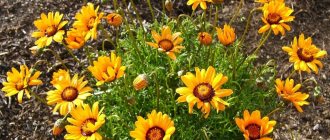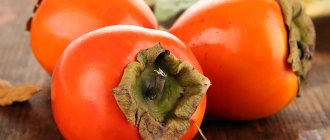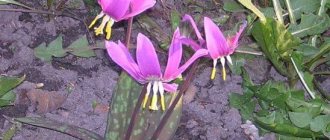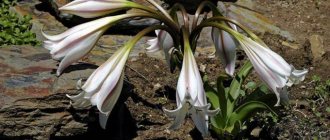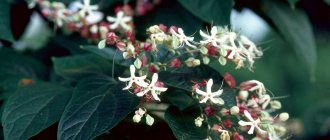Description of Heuchera Caramel
Heuchera "Caramel" is a low-growing representative of the fauna from the Saxifraga family. The bushes extend no more than 30 cm in height. It has a dome-shaped shape, completely covered with leaves that are golden in color with a copper tint. Young foliage is red in color, but over time it becomes like the rest of the foliage. In extreme heat they turn brown. Heart-shaped.
Flowering occurs in June-July. Very small buds with a pink tint appear. The flowers are collected in inflorescences resembling a panicle in shape. All of them are located on erect peduncles that stretch up to 60 cm.
Heuchera does not like sunny places; it reveals all its beauty best in partial shade. The wind is hard to bear. With proper care in the chosen place it grows quickly.
Heuchera “Caramel” does not tolerate cold well, so it must be covered before wintering. Oak leaves are suitable for this. Under no circumstances should you cut it before the onset of winter; there is a high risk that it will die. Damaged leaves are removed in spring. The culture does not grow well in harsh northern conditions.
Heucheras can decorate any flower garden or mix border.
Application in landscape design
Heuchera "Caramel" is unpretentious and suitable for planting in mixborders, rock gardens, coastal areas, city flower beds and simply for summer cottages.
The bushes go well with almost any plant; they perfectly complete the composition, forming a border around the flower bed.
Ideally combined with low-growing crops, in particular with:
- pachysandra;
- clarity;
- pure Byzantine;
- lungwort;
- peg;
- tenacious.
Heuchera looks great with ornamental grasses, as a tree-trunk frame for trees and shrubs. Effectively highlights the beauty of roses, hosts, geraniums and irises. To add uniqueness to landscape design, the Caramel variety is often mixed with other types of heuchera.
The bright color of the leaves and interesting shape allow you to fill the voids in the area during the flower off-season. Heuchera "Caramel" is planted between other crops to create a harmonious transition in the middle of the plantings. It looks good with other subspecies of the variety.
Heuchera "Caramel" goes well with low-growing plants in landscape design
Botanical characteristics of heuchera
The flower belongs to the colorful perennial plants of the famous herbal family “Saxifrage”.
The flower was first noticed on the rocky mountain slopes of the North American prairies. Heuchera received its exclusive name in memory of the German scientist I. G. von Heucher. He was a famous doctor, biologist and, of course, a fan of green plants. The unusual flower looks from the side like a half-meter rounded bush. Its main feature is its luxurious leaves. Many people believe that this plant is a real gourmet. In one season, it can change the color of its leaves several times. Not a single garden flower has as many leaf color options as Heuchera.
Its dense original bush consists of many leathery leaves with jagged edges. Each of them is held on a long stalk and has a special texture:
- with a smooth surface;
- corrugated;
- curly character.
Their colors are especially impressive:
- almost black;
- dark burgundy shade;
- bright red variations;
- purple palette of shades;
- pinkish and pale tones;
- yellow plates with a bright tint;
- various options of green shades.
In addition, leaves are:
- patterned;
- with veins;
- in small dots;
- with shapeless spots.
Heuchera blooms in early summer with small, cute buds, which are collected in original panicles. They are shaped like bells, so when you look at them, it seems like they are about to ring. Exclusive photos of heuchera varieties during flowering and lush decoration help to appreciate the unusual garden princess. The colors and shades of the buds are clearly visible on them:
- snow-white;
- pink;
- red;
- creamy.
Only with the arrival of autumn, fruits in the form of a box form in place of the buds. By the time it is fully ripe, it stores more than 20 thousand seeds, the size of a poppy seed.
Due to its wide variety and detailed description of heuchera, it is often used to decorate the garden area. And designers create unique landscape masterpieces from colorful flowers.
Reproduction methods
Hybrid heuchera "Caramel" can be propagated in several ways:
- division;
- cuttings;
- seeds.
The first method gives the best results. The best time is May or August. The bush for dividing must be 3 years old.
Only young plants, no older than 4 years, are suitable for cuttings. Only fresh and young sockets can be used. Preparations are made in February-March. Depending on the climatic conditions of the region, they are planted in May or June. The cuttings must be covered with film and removed only after roots appear, then planted in a permanent place.
For seed propagation of Heuchera "Caramel" only fresh raw materials are suitable. If the seeds lie for 1 year, then they are no longer suitable for planting. Therefore, the material obtained in the fall should be lowered into the ground only in the spring, preferably in early May.
When pre-growing seedlings, seeds are planted in pots in February. Grown-up young animals are sent to open ground in May.
The bush is subject to regular division and replanting. This must be done at least once every 5 years.
Heuchera "Caramel" can be propagated by cuttings, seeds and division
Care
Watering
Both waterlogging and overdrying of the soil are harmful to heuchera. In hot weather, the bushes are watered abundantly 2-3 times a week. After watering, the plants are loosened superficially so as not to damage the small roots. Mulching with plant residues and peat retains moisture well.
Feeding
Under natural conditions, heuchera can grow in poor soils. But in cultivation, in order for plants to show their decorative properties, they need additional nutrition.
Fertilizing should be moderate; excessive use of fertilizers leads to the occurrence of diseases.
On soils rich in organic matter, the first year of heuchera can do without fertilizing. Subsequently, the plants are fed with mineral complexes. The concentration of nutrients should be 2 times less than recommended in the instructions. During the summer, it is useful to dust young bushes with ash several times.
Transfer
Heuchera needs to be rejuvenated every 3-4 years. With a longer period of cultivation, the plant looks less decorative, becomes smaller, overwinters worse and may die.
In spring, heuchera roots and young rosettes often protrude to the soil surface and become bare. Therefore, every year the bushes are hilled up or an additional layer of earth is added around them.
Trimming
In young and immature plants, as well as in varieties valued for the beauty of their foliage, emerging flower stalks are cut off. This will save energy for the heucheras. They will direct them not to flowering and ripening seeds, but to increasing leaf mass. In varieties with beautiful flowers, pruning faded flower stalks stimulates the appearance of new ones.
During the summer, as young leaves grow, old foliage is gradually cut off. For winter, shoots and leaves of heuchera are not cut off.
Shelter for the winter
Some varieties, especially those with light leaves, and young heucheras need winter shelter. It will protect the bushes not only from frost, but also from spring burns. In the fall, the soil around the plant is covered with a layer of moss or mulch, and on top with spruce branches or lutrasil. The shelter should not be dense, otherwise the heucheras may dry out.
Plants that were planted in containers are brought indoors for the winter. A basement or a glazed and insulated terrace is suitable for this.
Landing algorithm
Hybrid heuchera "Mega Caramel" prefers partial shade. In any case, you need to watch the bushes for the first time. If it starts to dry out or there is no expressive color, then it will have to be replanted.
When several Heuchera are planted, a distance of 30 cm should be left between them.
Before planting, prepare a hole in which a hole is made for the root system. If its shoots are long, pruning is allowed.
Further actions:
- The root system is placed in a hole.
- Covered with earth.
- The horse's neck is deepened into the ground by 3-4 cm.
- The planting site is filled with water (5-10 l).
At the very end, mulching is carried out. You can use bark or grass for this.
Important! If the heuchera “Caramel” is replanted, then the young shoots must be deepened into the soil by 3-5 cm, more than the old crop.
Heuchera should be planted at a distance of 30 cm from each other.
Choosing a place and soil for planting
Heuchera grows well in fertile, loose soils with neutral acidity pH 5.5–6.5. Water should not stagnate in the soil, otherwise the rhizomes will quickly begin to rot. To drain excess moisture, deep drainage is arranged in the planting areas.
Sites for heuchera are chosen so that the plants are well lit in the first half of the day. In the sun the leaves become brighter. Some varieties prefer partial shade or shaded areas. Heuchera is often planted in the garden in the trunks of fruit trees and shrubs.
Growing rules
This plant is not demanding on soil quality. Poor development of bushes is influenced by 3 factors:
- abundant hydration;
- a huge amount of organic fertilizers;
- soil with high acidity levels.
All this can cause root rot and lead to the death of a representative of the flora.
For heuchera "Caramel" a single feeding per year is enough - in the spring. For this purpose, complex mineral fertilizers are used. The main thing is that they have low nitrogen content. Such products are labeled with the word “Autumn”.
If you do not want to use chemicals, wood ash is suitable for feeding, which is poured under each bush in a volume of 1 tbsp. l. It is recommended to lay a layer of humus on top as mulch.
Heuchera "Caramel" does not like pruning. Such activities are possible only after the appearance of new shoots. It is best to limit yourself to only removing old, diseased and damaged sheets. In winter they will act as a natural shelter. If you miss the time for feeding, then do not worry, just water the bush generously after the end of the growing season.
Heuchera "Caramel" responds well to spring mulching and loosening. The last procedure is carried out extremely carefully, the root system of the plant is close to the soil surface.
If dry weather sets in, then the “Caramel” heuchera needs to be watered, but not overdone. The culture does not like stagnant moisture, so the roots quickly die. It is best to irrigate or organize drip irrigation.
Bushes love drip watering
Preparing for winter
In order for heuchera “Caramel” to survive the winter well, it must be covered and under no circumstances cut off. Although in most of central Russia there is no need to even cover the bushes, in the northern parts you should not neglect the cover.
In cold regions, spruce spruce branches, thermal insulation materials or geotextiles can be used as insulation for the Caramel heuchera. It is best that the fabric is “breathable”, then it can be left until May. Experienced gardeners recommend removing the cover in May, after rain.
Under no circumstances should the plant be pruned before the onset of cold weather, especially if it will not be covered. Pruning of damaged and old shoots is carried out exclusively in the spring season.
Types and varieties
In the wild, heucheras are found in two different habitats: forests and mountains. Therefore, initially they can be divided into two large types. Forest plants quickly adapt to garden conditions with nutritious and moderately moist soils, since these conditions are close to their natural ones. For mountain species that live in rocky areas, soils rich in organic matter and overly moist will be destructive. They need to create certain conditions.
Modern breeders have created species that are more unpretentious and highly adaptable.
Blood-red heuchera (H.sanguinea) is a fairly hardy mountain species that feels great in our conditions. In the wild, its flowers are reddish in color, hence its nickname Coral Bells. This species was the first to be used by breeders in their work. They created varieties with more powerful, strong peduncles and branched inflorescences. The color of the flowers has a wide range: from white to dark red. Abundant flowering persists almost all summer. The leaves of this species differ in density; their color can be simply dark green or with silver spots and veins, and sometimes with beige or white specks. It handles our winters well. Prefers partial shade and well-drained soil. Drought-resistant, but suffers in sunny places.
This species is represented by the following varieties: Alba, Robusta, Splendens, Snowstorm, Splish-Splash, as well as the Bressingham Hybrids varietal group.
Heuchera hairy (H.villosa) is already a representative of the forest. The name is due to its distinctive feature - large velvety leaves, as well as pubescent peduncles and petioles. It has greenish-cream, unremarkable small flowers. But one of its natural varieties, “Bronze Wave,” is a record holder among purple-leaved heucheras, since its bronze-colored leaves can have a diameter of up to 20 cm. Since this is a forest species, it requires soil rich in moisture and humus. Accordingly, it grows well in partial shade. Varietal plants of this species may have light green, purple or bronze leaves. A famous variety is Palace Purple.
Heuchera blood-red Variety “Splendens” Heuchera hairy Variety “Bronze Wave”
Heuchera cylindrica (H.cylindrica) is a hardy mountain species, characterized by relatively small leaves and fairly large flowers. The leaves are round in shape with blunt teeth and have a silver pattern or contrasting veins. Cylindrical inflorescences are located on high (from 60 to 90 cm) peduncles. In nature, bell flowers are greenish-beige. The color of different varieties can be beige, pink, coral, green. This species requires good drainage and grows in sun and partial shade. Varieties of heuchera cylindrical: Green Ivory, Greenfinch, Hyperion.
Heuchera americana Variety “Green Spice”
American heuchera (H. americana ) is a representative of forest edges; its second name is mountain geranium. The flowers are completely unremarkable yellow-green, and its main advantage is the large, jagged leaves of variegated color. Silvery spots and purple veins look unusual against a green background; the entire lower part of the leaf can also be purple. Some varieties have a red-crimson stripe along the edge of the leaf, but this phenomenon can only be observed in regions with warm winters.
The most spectacular representative of this species is the Green Spice variety.
Heuchera small-flowered (H.micrantha) - has tall (up to 70 cm) brownish peduncles, on which small beige flowers are collected in openwork panicles. The leaves of this species are beautiful, somewhat reminiscent of the familiar Norway maple. An interesting detail: the winter foliage of this plant is round, and the summer foliage is lobed. The color is traditionally dark green with beautiful silver spots, but there are varieties with purple foliage. Breeders tried to diversify the color of the leaves to black-brown and rich purple-bronze. Prominent representatives of this type are Palace Purple and Bresslngham Bronze. Soils need to be well moistened, with a small addition of organic matter.
Hybrid heuchera (Heuchera x hybrida) - scientists have created hybrid species of heuchera. Thus, as a result of crossing blood-red, American and small-flowered heuchera, a species called heuchera shaken (H. x brisoides) was obtained. As a result, we achieved longer flowering, as well as fairly large leaves and flowers. The colors of the new species of plants are white, pink and various shades of red. Green leaves with contrasting veins and specks. A small drawback is that heavy flower panicles can be blown over by the wind.
Heuchera small-flowered Variety "Palace Purple" Heuchera hybrid
Complex hybrids were obtained as a result of crossing heuchera small-flowered, American, hairy and others; they were combined into the type of American hybrids (H. x americana) .
Diseases and pests
Heuchera "Mega Caramel" is classified as a plant with a low probability of disease occurrence; it is not afraid of pests. 90% of all problems appear solely due to waterlogging and increased amounts of fertilizer. Hence the conclusion that a lazy owner’s plant always looks better.
It is extremely rare, but still the plant can suffer from:
- snails and slugs;
- powdery downy mildew;
- rotting of the root system.
In the first case, it is best to transplant the bushes to a more illuminated place - this is the simplest solution to the problem. The drug "Intair" will help.
The second problem is solved with the help of special protective agents, fungicides.
In case of root rotting, there is only one solution - stop watering and fertilizing the bush. If this does not help, then dig up the plant, remove damaged root shoots and plant only in new soil. It is recommended to provide additional drainage so that excess moisture does not accumulate in the pit.
It is extremely rare that a plant can suffer from caterpillar larvae and chafer beetles. The problem is solved with the help of insecticides with the obligatory removal of damaged shoots, leaves and buds.
Copper-containing drugs are used as prophylaxis. They spray the bushes and the ground around. The procedure is carried out during the beginning of the growth of green mass.
Heuchera "Caramel" is easy to care for
Heuchera Americana
This is a wild species of heuchera that grows freely in rocky areas of North America, which is why in its homeland it is called mountain geranium. The peculiarity of American heuchera is the red-crimson border along the edge of the leaves, which appears on them in winter. Unfortunately, this effect cannot be achieved in the middle zone. In warm years, a slight coral tint will appear on the leaves in late autumn.
Green Spice
Green Spice is the most popular variety of American Heuchera. It was developed in New Zealand and quickly spread to America and Europe.
Heuchera Green Spice is attractive with its light green-silver leaves with green veins and a border along the edge. She loves shady areas and moderate watering.
| Bush height (cm) | Bush width (cm) | Distance between plants (cm) | Flowering time | Lighting |
| 22-90 | 30-60 | 30-45 | End of May – beginning of July | Penumbra, shade |
Marvelous Marble
Marvelos Marble can add noble bronze accents to your flower garden: this is the shade inherent in its dark green leaves with purple veins. In late spring - early summer, this heuchera blooms with modest snow-white flowers.
Marvelos Marble bushes are unpretentious, are not afraid of bad weather and pests, and are ideal for mixborders.
| Bush height (cm) | Bush width (cm) | Distance between plants (cm) | Flowering time | Lighting |
| 30-60 | 30-40 | 30-45 | End of May – beginning of July | Sun, partial shade, shade |
Paris
Like Green Spice bushes, the leaves of this heuchera are mint with a silvery tint, and the veins, as expected, are dark green. During flowering, the plant looks stunning - all thanks to its elegant bright pink flowers.
This beauty is not afraid of drought or frost, practically does not get sick and does not need complex care.
| Bush height (cm) | Bush width (cm) | Distance between plants (cm) | Flowering time | Lighting |
| 17-30 | 30-60 | 30-40 | End of May – end of August | Penumbra, shade |
Heuchera propagation by dividing the bush
Every year, the basal rosettes of the flower grow in height, while at the same time the lower, dried leaf plates fall off. This process leads to exposure of the internodes, which creates an external resemblance of the plant to a palm tree. Most often, changes can be noticed in the 3rd–4th year of the culture’s life.
It is recommended to divide shrubs with palminess. If this method of propagation of heuchera is neglected in the spring, the flower begins to lack nutrients, and the shoots themselves dry out.
Dividing the bush has a beneficial effect on its growth and development:
- the propagation procedure rejuvenates the shrub, allowing it to better tolerate winter frosts and summer heat;
- strengthening the immune system, increasing resistance to harmful insects and diseases.
If this method of propagation is abandoned, the “palminess” of the shrub increases, as a result of which the bare stems break under the influence of external factors, which leads to the death of the plant.
Rules for dividing heuchera in spring:
- the bush is removed from the soil, trying to keep the root system intact as much as possible;
- the roots are thoroughly washed using running water;
- Using a sharp knife, divide the bush into several parts so that each of them has several rosettes;
- It is recommended to cut off excessively long roots;
- all rotten parts affected by disease or pests are removed to healthy white tissue;
- fresh sections must be sprinkled with a mixture of charcoal and growth powder or use the product “Kornevin” and “Ukorenit”;
- remove all dry parts of the plant, then plant the separated parts around the area; to do this, place the heuchera in the prepared hole, then sprinkle it with soil so that the leaves and rosettes remain above the surface of the soil, after which the plant is watered abundantly;
- As the heuchera grows, it is recommended to add soil or mulch until the ground around it is completely leveled.
Heuchera takes root favorably after the propagation procedure with proper care: immediately after transplantation, the shrub needs shelter and regular watering, loosening, and weeding until it is completely rooted.
When to plant heuchera.
Heuchera is planted in March or April. Heuchera has good shade tolerance, so the best place for it is in the partial shade of other plants, where diffused light will fall on it. The best option is the eastern or western side, where direct sunlight falls only in the morning or evening. If this is not possible, and you have to plant it in the sun, then you need to provide the heuchera with regular and more abundant watering. By the way, varieties with brightly colored leaves in an open sunny area become even brighter and more spectacular. And varieties with red leaves must grow in the sun, otherwise their leaves will remain green in the shade.
Heuchera is not picky when choosing soil; it can grow on any soil except acidic soil, the optimal pH is 5-6. Even a rocky area does not frighten the plant, because in nature, in its homeland, it covers the rocky shores of the Great Lakes. But the more fertile and loose the soil, the more attractive and lush the heuchera. Moisture capacity and, at the same time, good drainage of the soil on the site are of great importance. Heuchera does not tolerate stagnation of water in the roots.





